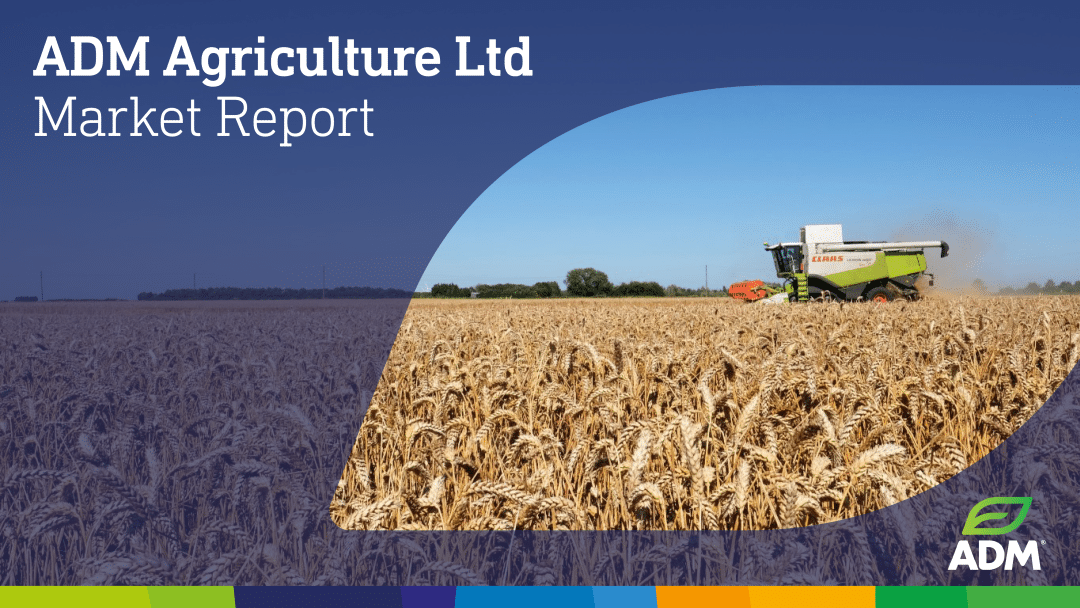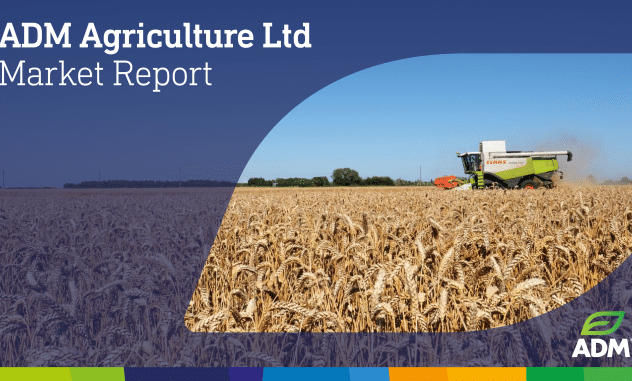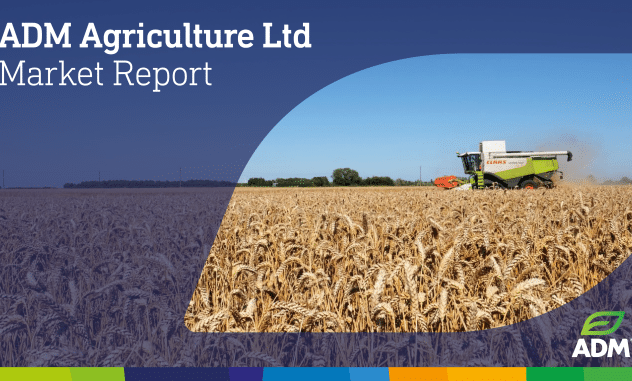WELCOME TO THE ADM AGRICULTURE WEEKLY MARKET REPORT
Wheat
- US prices have fallen $2.39/t w/w.
- Despite a firmer US$, wheat values are still competitive onto the global markets. US exports have slipped over the past two weeks, but are still running 34% ahead y/y, and have reached 41% of the yearly export projection.
- European prices have fallen €4.00/t w/w, as continued shipment from the Black Sea regions pressures. Reports of lower yields, as the Russian harvest completes, has resulted in analysts trimming their production forecast for 2024, and the continued dry weather, which has delayed winter plantings, is potentially seen lowering production for the third consecutive season in 2025. European exports continue to struggle, seen 31% lower y/y, although the bleak export outlook is balanced by talk of lower production, and increased domestic usage.
- UK prices have traded £2.20/t lower w/w, although delivery premiums continue to rise, on the lack of fresh supplies hitting the market. Growers continue to concentrate on fieldwork, sowing crops as the planting window begins to narrow.
- All-in-all, this remains a tough market to call. The bearish factor of a general lack of global demand, is being offset by the talk of potentially lower production, and stock reduction. Russian and Ukrainian export prices continue to set the market, while EU and US prices remain at the high end of the range. The availability of Black Sea exports will be key to the direction of the market, although any drop in export supply could be covered by supplies from the Balkan and Baltic states, and soon to be available Southern Hemisphere crops.
- Seems a market where any dips are deemed buying opportunities, and any rallies are deemed selling opportunities!
Feed Barley
- For another week, feed barley is a broken record story and low liquidity remains the key theme. With lower futures on the week and a lack of farmer selling, the spread between wheat and barley has been squashed back in.
- Anecdotally, feed demand in the UK is supported on barley’s competitiveness, however consumers are conscious of the heavy S&D and generally seem reluctant to lock in forward purchases of any volume.
- We are still uncompetitive into export markets, despite a sizeable surplus of malting barley in the country.
Malting Barley
- Malting barley markets are once again a rather dreary picture. Activity is extremely slow and we continue to see a lack of appetite from consumers. AHDB have just released their latest S&D update for 2024/25 season which reports malting demand lower by 83Kmt (4%), supporting the activity we see in the market today.
- Premiums continue to hang around at recent lows, which is limiting farmer selling. If demand were to pick up, then premiums may need to appreciate in order to stimulate farmer selling, but once again this seems like a remote prospect.
Rapeseed
- This week has been positive for Ag markets as the case for demand seems to be improving. Prices are still trending lower, though so far this week we have seen good support from $9.69 on the November contract. In the US, soybean harvest continues at the fastest pace for 7 years with this week’s report showing 81% complete vs. last week at 67% and 72% last year, there is not a single state behind schedule. We have started to see rain in the forecast for a few states, but this shouldn’t be enough to delay harvest. In South America, rain has started to fall, improving the soil moisture and looks to continue for the next 10 days. ANEC expects Brazil’s October exports to reach 4.63 mln t, higher than previous forecast of 4.34 last week. EU bean imports released on October 20th reached 3.73 mln t, up from 3.49 mln t a year earlier.
- Crude oil has been less volatile this week, settling for now towards the middle of recent large fluctuations. China cut its benchmark lending rates this weekend by an expected 25 basis points to 3.10%, which did bring optimism surrounding future demand. China’s GDP grew 4.6% in the third quarter which was better than the 4.5% expected, but below the previous 4.7%. China’s refinery output in September was down 5.4% from last year, giving us the sixth consecutive month with a decline. This week’s API report showed US crude oil stocks up 1.64 million barrels last week vs. expectations for a 300,000 barrel increase.
- Canola has followed outside markets higher this week as improved speculative buying has brought cash bids back above $14/bushel, letting farmers commit more of their crop. On Friday we saw confirmation of Canada imposing tariffs on Chinese EV’s, as well as aluminium and steel, which led to Chinese rape oil dropping over 3% on Monday, but we haven’t heard much from this since.
- This week MATIF rapeseed prices have come higher again to hit the contract high for the February contract at €517. Prices have been unable to break through this so far and will likely need some help with pre-Christmas coverage in the US and Eu looking positive, though in the new year there is plenty to be done. In France, sunflower harvest is well behind the curve, meaning that a few consumers have been switching nearby commitments to rapeseed which has helped support prices.
Oats
- Over the course of the last week, EU oat markets have seen further buying activity with consumers continuing to take cover for Q4’24 and Q1’25. Consequentially, prices have remained supported.
- Scandinavian sellers for Q4 are now hard to come by with collectors reporting a lack of farmer selling.
- Feed oat demand remains hard to find, but some trades have been reported into ARAG.
- Farmer selling is widely reported to be slowing down with most focussing on land work and drilling next year’s winter crops.
- Here in the UK, demand has picked up, with prices rising from the harvest lows. Consumers are buyers for Q4’24 onwards, however space for Nov/Dec’24 is getting tight.
- Export interest for UK oats has increased with some trades being rumoured, but more is needed to put a dent in our surplus.
- Plantings of next year’s crop has progressed well in some areas but not well in others, however, given the success of last year’s spring crops, it would not be surprising to see further switching to springs at the expense of winter varieties.
- Bottom line, oat prices have been supported by the recent buying activity, but the UK will need to see strong exports to maintain the current price actions.
Pulses
- Beans continue to be harvested across the northern half of the UK, although moistures are certainly a concern, with beans in excess of 25% moisture not being uncommon, pushing drying capacity with the sheer volume that are coming in from the fields. Quality does appear to be relatively good in all of these, however, this will all depend on growers being able to rapidly get the moistures in check. With the recent softening of imported feedstuff prices, beans aren’t looking quite as attractive in the diet, and this has tallied with a slowdown in compounding interest across the UK. Egypt continues to show limited interest for processed beans in to the export market.
- In the week ahead, the UK is forecast to see a mostly dry week, supported by above average temperatures for the time of year, no doubt a welcome reprieve for growers with beans still to cut or dry. Turning to the rest of Europe, the Baltic is set for a similar weather pattern to us here in the UK, although Spain and France will see further rainfall.
- More and more northern beans are starting to come through our labs, and the samples, aside from the moisture, are looking ok. However, as already mentioned, the moistures could well be the undoing of this if growers don’t manage to get beans dried in a timely manner. Additional premiums are available for growers with good-quality beans, so it is worth regularly talking to your farm trader and pushing samples across if they look like they have potential, as we may be able to upgrade them for you and pay an additional premium if they hit spec. With the current pricing structures in the feedstuffs markets, feed beans need to come c. £15/mt lower, relative to other commodities, to start buying some more demand again. As written in previous reports, with all this factored in, feed is only likely to come under further pressure and be squeezed lower.
- The winter drilling season is gathering momentum across the UK for a number of crops, with growers keen to make the most of this dry spell. It is well worth making time to talk to your farm trading representative, as they will be happy to advise you on what contracts we have available. With a combination of great marketing options, various seed stocks ready to go, and a portfolio of cost-effective inputs, such as P-Grow and FibroPhos that can help push your yield potential, they are ready and happy to help. We are buyers across a wide spread of homes nationally and can offer you competitive origination markets, plus the opportunity to upgrade any crops that may be fit to human consumption pulses to be processed in one of the most advanced pulse processing plants in the UK and Europe, all while earning an additional premium for your crops.
- Finally, the ever-present PGRO plug to those eligible to be members. If you are not already signed up to the PGRO mailing list, you can sign up here where levy payers can access all sorts of advice and support, tapping into their extensive knowledge bank on all things pulses for free!
Seed
- In areas of the UK drilling has restarted due to drier weather this week. We have multiple floor stocks available for fast delivery, including the highest yielding feed wheat LG Beowulf, and tonnages of varieties with additional dressings like latitude.
- As we begin to look towards spring, we have great varieties available, including MBC approved for brewing and malt distilling, Laureate, RGT Planet – a widely grown variety and SY Tennyson – a high yielding provisional MBC variety.
- Alongside our range of barley varieties, we have multiple pea seed varieties available too including LG Adder, Kabuki, Daytona, Butterfly and Concerto. We are also pleased to offer buybacks alongside these varieties, please speak to your ADM farm trader for more information.
Fertiliser
- Market Overview: Long periods of illiquidity interspersed by brief buying activity have punctuated the market over the past weeks in all major fertiliser commodities. Nitrogen continues to lead the upward charge driven higher by the notable supply chain risks posed by ongoing tensions in the Middle East. The dollar’s three-month uptrend underpinned by slower interest rate cuts by the federal reserve, and speculation surrounding the upcoming US election, will compound these supply chain risks presenting the imported urea market with challenge heading into Q4. Eyes remain focussed on the rumoured Indian tender expected to imminently for late Q4 delivery following a failed attempt to secure adequate levels (0.56Mt) in its October 3rd tender.
- Natural Gas: European natural gas futures have risen above €42 per megawatt-hour, approaching their highest level since December 1. This increase is driven by heightened gas demand for power generation and escalating concerns over geopolitical tensions in the Middle East. Forecasts of lower wind speeds next week is expected to boost gas-for-power usage, while foggy conditions could reduce solar power output and raise heating demand. European LNG supply is lagging behind last year’s levels, raising worries that higher demand could prompt early withdrawals from gas storage, which is currently 95.31% full. Market participants are closely monitoring tensions in the Middle East, particularly the risk of supply interruptions through the vital Strait of Hormuz. Despite diplomatic efforts, ongoing conflicts keep markets on edge.
- Urea: Urea prices remain firm despite the absence of significant purchasing activity in Brazil or Europe and despite NOLA prices declining again. The prospect of India re-entering the market without any indication of Chinese exports resuming appears sufficient to maintain the upward trajectory. In the UK, volumes onto farm have remained limited.
- Ammonia: The ammonia market is finely balanced moving into the second half of October. Capacity constraints on both sides of the Suez Canal are seemingly offset by relatively limited demand from downstream importers.
- Potash: Potash market sentiment is likely to remain mixed this week, as some market players anticipate that a price floor has been reached. Southeast Asian MOP prices may stay flat to firm as the market seeks direction from the latest Pupuk tender. Offers are rumoured to be around $310 per tonne CFR, significantly higher than current market levels of $280-300 per tonne CFR.
- Phosphate: India still requires a large volume of DAP, but has limited options to procure it and limited time in which to do so, though prices have remained surprisingly stable over the past two weeks. Meanwhile, U.S. markets for DAP and MAP have continued to firm. Mosaic announced on October 21 that it will lose up to 250,000 tonnes of production due to hurricanes in Florida.
- UK Nitrogen Statement: In the UK what limited nitrogen volume being traded remains at unsustainable levels when replacement values are considered. Existing stock is allowing the market to remain at current values, however, once replacement is considered, there is scope for further price increases. This unfortunately will coincide with many growers’ timeline for spring volume considerations following a challenging drilling window throughout the country.
- Whilst small volumes of nitrogen are being purchased for spring, growers should be considering requirements, particularly where forward grain contracts are being secured to hedge their exposure in a volatile environment.
- Please contact your ADM Agriculture farm trader for more information on forward grain contracts and the tie-ins with nitrogen purchasing.
| £/€ | £/$ | €/$ |
|---|---|---|
| 1.2020 | 1.2980 | 1.0800 |
| Feed Barley £ | Wheat £ | Beans £ | Oilseed Rape £ | |
|---|---|---|---|---|
| Nov 24 | 155-170 | 184-199 | 200-215 | 410-415 |
NB: Prices quoted are indicative only at the time of going to press and subject to location and quality.
Although ADM Agriculture takes steps to ensure the validity of all information contained within the ADM Agriculture Market Report, it makes no warranty as to the accuracy or completeness of such information. ADM Agriculture will have no liability or responsibility for the information or any action or failure to act based upon such information. ADM Agriculture cannot accept liability arising from errors or omissions in this publication. ADM Agriculture trade under AIC contracts which incorporate the arbitration clause. Terms and Conditions of Purchase.
On every occasion, without exception, grain and pulses will be bought by incorporating by reference the terms & conditions of the AIC No.1 Grain and Peas or Beans contract applicable on the date of the transaction. Also, we will always, and without exception, buy oilseed rape and linseed by incorporating by reference the terms & conditions of the respective terms of the FOSFA 26A and the FOSFA 9A contracts applicable on the date of the transaction. It is a condition of all such transactions that the seller is deemed to know, accept and understand the terms and conditions of each of the above contracts.



